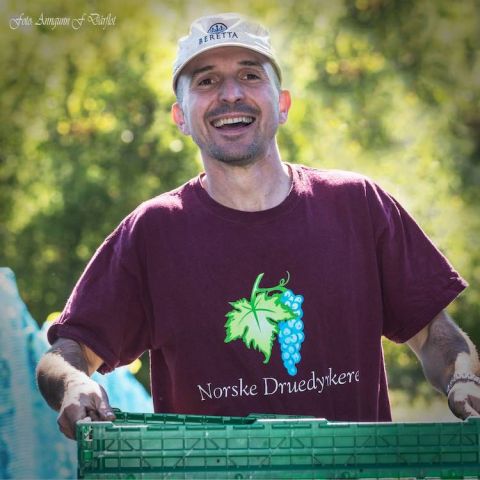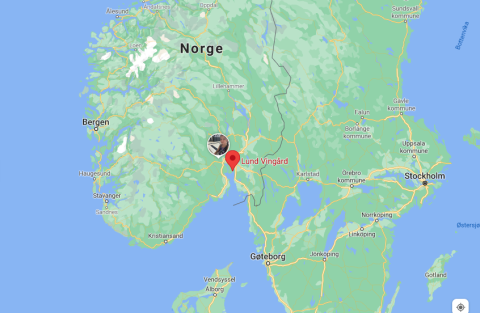Surprising and eminently drinkable proof of climate change.
Substitute red wine from €10.90, $17.99, £16.95, 160 Danish kroner.
Find the substitute red wine.
The criteria when choosing our wines of the week are that the wine should be:
- interesting
- good value (not necessarily inexpensive, though our choices do tend to be reasonably affordable)
- preferably available retail in the two countries in which a total of about 60% of our visitors are based, the US and the UK.
Today I am being extremely naughty and choosing a wine that is definitely interesting (even thoroughly unexpected, one might say) but is hardly available commercially. In fact to find a bottle, you would probably have to go to a restaurant in Norway. So I apologise in advance that my recommendation is of practical use to such a small proportion of our visitors.
But when I interviewed Nayan Gowda about his Bolivian winemaking project recently, he recommended I inform myself about a Piemontese engineer currently making wine in Norway. Having learnt more and tasted his most recent vintage, I hope you will be as fascinated by the story as I am.
Danilo Costamagna went to Norway in 2002 to study telecommunications engineering as part of the Erasmus EU educational exchange programme. At university he met Marte, a medical doctor and neuroscientist, who became his wife in 2011 after he had moved to Norway permanently in 2009. After working an an IKT engineer, about nine years ago he decided instead to become a kindergarten teacher while studying wine and winemaking in detail.
According to Gowda, who helped him with his 2019 vintage, Costamagna had always been passionate about wine, and so started a side-project importing wines from Piemonte. But he became convinced that wine could be produced successfully in Norway from hybrid varieties bred especially for cool climates, and started dabbling with grapes from experimental plots and hobby growers. His favoured hybrids are the early-ripening Solaris for whites and Rondo for reds, each of these popular in Sweden, Denmark and the Netherlands. (And quite a bit of Rondo is grown in the UK too.) A happy Costamagna is pictured below by Anngunn F Dårflot.
‘One thing I really like about Danilo’, says Gowda, ‘is that he has a brilliant brain. He is a sponge for information and understands differences in causation and correlation when it comes to winemaking and viticulture. And he understands what "quality" means. He’s a natural and he’s highly driven. If anyone is going to put Norwegian wine on the map, it will be him.’ As an afterthought he added, ‘I had never considered moose a vineyard pest prior to going to Norway’.
On JancisRobinson.com we have already reported on the little Riesling and Pinot Noir vineyard in Norway in which Klaus Peter Keller of Rheinhessen has had a hand. According to this article translated from Norwegian, there are now about 40 registered wineries in Norway, although most of them are embryonic and very small, with some growers tending only about 200 vines. Neverthless, there were 29 entries in the recent annual Norwegian wine awards.
Costamagna won Norwegian Winemaker of the Year in 2017, which encouraged him to found a company called Norsk Vin, drawing grapes from many of these vineyards. The oldest, in Asker just outside Oslo, was planted in the early years of this century and Costamagna has benefited enormously from the expertise gained there, but most of the other vines he works with are very much younger. He took the picture at the top of this article, of a south-facing slope in the Lund vineyard with which he worked last summer. It’s close to the Oslo fjord as shown below. Proximity to fjords helps moderate extremes of temperature and the risk of frost at these high latitudes.
He sent me a couple of bottles of his Andante dry white, 2019 and 2020 made from Solaris – probably the only two bottles of Norwegian wine in France, for which UPS asked, in addition to the cost of shipping, duty of €20 and a €60 ‘liquor fee’. The 2019 was really unacceptably tart but the Norsk Vin, Andante 2020 Norway was a very respectable crisp, fruity wine indeed, much enjoyed by our large household. I described it as ‘a little more floral in flavour than a Chablis but not at all unlike a Chablis in structure’.
Costamagna observed in an email, ‘In 2019 we had only 82 Oechsle in the must so we had to chaptalise a little. With the high acidity, we should have used it as a base for sparkling wine. In 2020 we had 92 Oechsle in the must which we were very happy with. In addition to that I have gathered grapes from different vineyards and we have tried to limit the total number of clusters per vine. But my goal is absolutely to improve further in quality. Solaris grapes have the tendency to overcrop. All being rather young vines between five and 10 years old, it is challenge to achieve balance. I am currently testing different rootstocks and cover crops in order to achieve that.’
His winemaking notes:
‘We still have very limited equipment and laboratory but:
1. In both vintages the must was cold-settled with a pre-fining of bentonite.
2. In both vintages we used EnartisFerm Q Citrus yeast. But in 2020 I have tried with limited tools to control a bit more the fermentation trying to keep it close to 15–16 °C.
3. The wine hasn’t gone any malolactic conversion in order to keep the fresh fruitiness.
4. Again with limited equipment in both vintages I used CO2 sparging and limited use of sulphites.
5. There have been also limited racking operations but for 2019 and 2020 I had to use centrifugal pumps which might have been a little rough in terms of aeration. I am hoping for the future to use better pumps to further improve this also.’
I gave the 2020 blind to an ex-winemaker friend who was completely foxed by it, guessing it came from ‘somewhere quite warm’.
Costamagna sells his wines for between 250 and 300 Norwegian kroner (£20 to £25/€24 to €29/$28 to $34) only to restaurants and hotels in Norway for the moment since annual production is tiny: 400 bottles of white and 200 bottles of red. But he says, ‘the goal is to sell to private customers through the Norwegian monopoly (Vinmonopolet) within two to three years when the total production will hopefully reach a minimum of 2,000 bottles’.
He is aiming to to boost production to a mammoth 5,000 bottles eventually, thereby justifying establishing a common production facility for both still and sparkling wine production in south-east Norway with three other vineyards. A sparkling raspberry wine is in the works.
I’m sure we will be seeing more and more worthwhile wines from the far north of Europe in future. Which is my excuse for choosing such an exotic wine to describe to you, but I feel bad not to highlight something easier to find so am also wholeheartedly recommending a complete contrast: Dom de Mourchon, Tradition 2018 Côtes du Rhône-Villages, Séguret red. This domaine, painstakingly run by the McKinlay family, originally from Scotland, is no stranger to these pages. See this 2019 wine of the week, for instance. They received their organic certification in 2020 and are now in conversion to biodynamic farming with Demeter.
This 2018 is a full-bodied red that offers a beautiful, ripe, herbal taste of the southern Rhône but with surprising freshness – presumably thanks to the 350 m (980 ft) elevation, which also saved them from the April 2021 frosts. According to Wine-Searcher.com it’s available in Germany, France, the US, the UK and Denmark and it’s delightfully ready to enjoy.
See also this guide to our extensive coverage of Rhône 2018.



